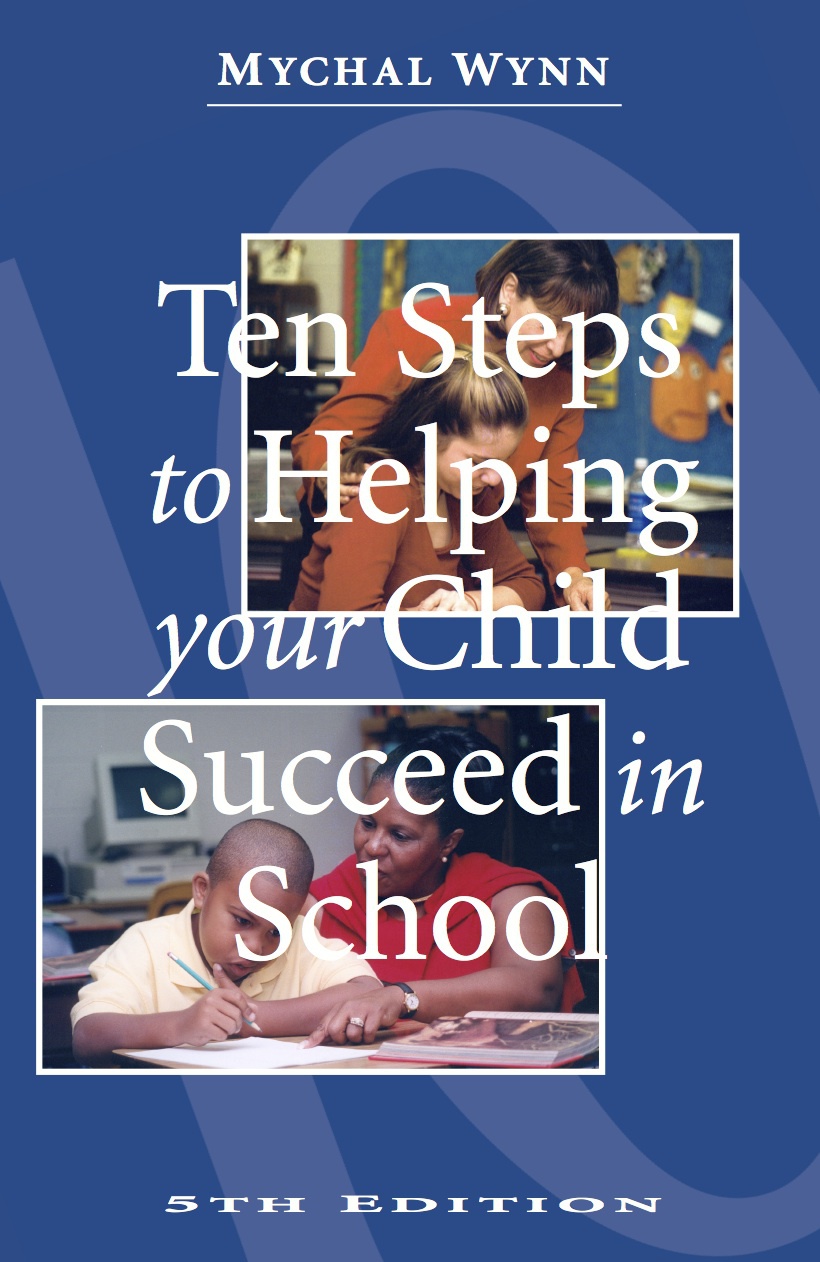|
September 7, 2016
Pictured in the cover photo for this newsletter are my wife and younger son (now 22 years old). My wife was volunteering in his elementary school classroom during a literacy lesson. From the time our children entered preschool, our expectations were that they were on their way to college and that they needed scholarships to pay for college. It is easier to deal with the challenges of working with today's high school students when parent expectations were established during the primary grades.

In our work, we provide staff development for teachers; contract with school districts where we work hands-on with students (as pictured above), typically with little parental involvement; and work with both students and parents in our College Planning Cohorts. It was an email from a parent of one of our College Planning Cohort students that I received today, which provides the focus of this newsletter:
“Hi Mr. Wynn,
I'm having a hard time getting my 10th grader motivated to work on the cohort activities. This isn't what I had planned for her. She won't study for the SAT or the ACT.
Now that she hasn't been working the program, she isn't guided in the right steps to making a final decision of her college major and selecting a school.
I'm in a difficult decision space right now and I think if she'd been working the program it would make my decision easier. Janice is in dance and has been since 3. She isn't going into a dance major in college. She also has an opportunity to join a great after school orchestra program for nearly free. She likes both programs. She wants to be a writer (author) and major in English and literature. She attends a writing camp yearly in the summer time. I don't know if she's really into playing the violin to use it as a way to earn a scholarship into college. But I know she enjoys playing the violin.
Ultimately, how can I get her to understand the importance of doing the activities, being engaged, studying for the ACT and SAT and how I can help guide her into the right direction?”

The matter-of-fact response is, “You are the parent and she is the child. Make it clear to her, in no uncertain terms, that you ‘expect’ her to do the activities...period!” Many parents (and some students) will agree with this response, however, I believe my book, “Ten Steps to Helping Your Child Succeed in School” outlines a more substantive approach that this parent, or any parent, will find beneficial.
Step 1: Get to Know Your Child
“Getting to know your son or daughter is the first, and arguably, the most difficult step. As parents, we grew up in a different generation. We were taught different values than those constantly being directed at our children through today’s music, movies, literature, and advertisements—not to mention the Internet.” (p. 1)

Getting to know your children will provide you with a better understanding of how to motivate them, whether through rewards (e.g., opportunities to hang out with friends), withholding what they want (e.g., braids and hair weaving), or enforcing consequences (e.g., no cell phone, no latest fashions, no television). What works for one child will not necessarily work for another child, and what your parents did to you will not necessarily work for your children. While almost every child has a cell phone, few parents appear to recognize that they purchased the phone, assumed responsibility for the contract, and pay the monthly bill. This failure to recognize, “Who the cell phone belongs to,” has led to children proclaiming, “That’s my cell phone.” The fact is that a cell phone is one of many privileges that parents have the power to determine whether or not the ‘privileges’ are extended.
Step 2: Identify the Best School (or Program)
“Consider the first step of getting to know your child as the first piece of your parenting puzzle. All of the other pieces must now be put into place in relation to the first piece.” (p. 49)
 Identifying the best school, or programs, requires an understanding of each child’s gifts, talents, interests, motivations, and aspirations. Parents must delineate between interests resulting from intrinsic motivation (i.e., “I want to”), peer pressure (“My friends want to”), or cultural constructs (i.e., “All the kids do it”), none of which may be reflective of their child's gifts and talents. For example, our older son was an athlete who played football, lacrosse, ran track, and had a black belt in martial arts. However, while he loved sports, art was a natural gift that first revealed itself through his kindergarten stick people. Beginning in kindergarten, my wife and I nurtured his gift through summer camps, after school programs, mentors, and his elementary-through-high school coursework. His 11th-grade AP Studio Art Portfolio paved his way into scholarship opportunities and his ultimate acceptance into Amherst College, where he submitted his art portfolio as a supplement to his college application. Identifying the best school, or programs, requires an understanding of each child’s gifts, talents, interests, motivations, and aspirations. Parents must delineate between interests resulting from intrinsic motivation (i.e., “I want to”), peer pressure (“My friends want to”), or cultural constructs (i.e., “All the kids do it”), none of which may be reflective of their child's gifts and talents. For example, our older son was an athlete who played football, lacrosse, ran track, and had a black belt in martial arts. However, while he loved sports, art was a natural gift that first revealed itself through his kindergarten stick people. Beginning in kindergarten, my wife and I nurtured his gift through summer camps, after school programs, mentors, and his elementary-through-high school coursework. His 11th-grade AP Studio Art Portfolio paved his way into scholarship opportunities and his ultimate acceptance into Amherst College, where he submitted his art portfolio as a supplement to his college application.
Step 3: Develop a Plan
“Now that you have gathered information about your child and your child’s school, you need to develop a plan. What do you want your child to learn, experience, or be exposed to this school year?” (p. 91)
Developing a plan provides a context for the College Planning Cohort activities. Since this parent believes that her daughter’s participation in the College Planning Cohort is an important part of her family’s plan to pave the way for her daughter into college, earn the necessary scholarship money to pay for college, and most importantly, avoid student loan debt, then the parent needs to clarify the plan for her daughter and hold her daughter accountable to the plan.

College planning is not a student's plan or a parent's plan, it is a family plan. The mother and daughter should work together in developing the plan. The mother may begin the conversation by completing the activity, “A Context for the Conversation” with her daughter. Once her daughter expands her understanding of the connection between the college planning activities and pursuing her own dreams and aspirations, she may become more intrinsically motivated to complete the activities and share what she learns with her mother.
Step 10: Stay Focused on the Dream
“Unlike many of the other children, our son had a 'dream' of becoming an artist. His field trip [High Museum of Art] tapped into his interest and had a direct connection to his dreams. For the other children, it was an opportunity to get away from school and ride the school bus. This is not do diminish the academic and cultural value of the field trip itself, but only to highlight the importance of providing opportunities for field trips and enrichment opportunities to relate to the drams and aspirations of more students.” (p. 176)
While Steps 4 - 9 provide many important parenting tips and strategies, we can jump to the Step 10: Stay Focused on the Dream. This mom says that her daughter wants to become an author and major in English and literature. The video of students participating in the program, "Get Lit" shares the poetry of 3 brilliant young writers and spoken word artists who may provide further inspiration for her daughter. Consequently, the conversations regarding the college planning activities should focus on how the activities will assist her daughter in identifying the colleges where she may pursue her dreams, the attributes these colleges value in admitted students, and the grades, test scores, and accomplishments that will make her a strong candidate for admission. The scholarship research may begin with poetry and creative writing competitions. In this way, both mother and daughter will be enriched through the process of following the plan.
Strategies that may evolve from each of the steps
Step 1:
- Make a list of everything that you provide for your child. The list might include such things as:
- Cell phone
- Hair weave
- Beauty Salon
- Clothing
- Food
- Money
- Television
- Internet
- Video Games
- Video Game Systems
- Paying for school-related activities
- Paying for after-school activities
- Make a list of everything you want your child to do (e.g., College Planning Cohort activities, homework, ACT/SAT prep, household chores), followed by these simple statements,
“After you complete the College Planning Cohort activity and discuss what you learned with me, you can do...”
“Each College Planning Cohort activity you complete earns you 24 hours of cell phone privileges or one hour of video game playing.”
“All of your fashionable clothes are now in my closet. Complete a College Planning Cohort activity in exchange for a garment.”
Step 2:
Identify the schools, programs, and activities for those gifts and talents you believe to have scholarship potential. Sit down with your child and explain your plan:
- “I cannot afford to pay for you to go to college and I will not take out any student loans. Therefore, we need to focus on developing one gift to scholarship potential. You can choose the gift, and then we will focus school-related and after-school activities on developing the gift.”
- “If you do not make the commitment to the academic achievement and gifts/talents needed to earn scholarships, then plan to attend community college.”
Step 3:
Oftentimes parenting is not easy, our children are defiant, undermine our efforts, and behave as though they are entitled to all that we do for them. However, developing a college-bound plan requires engagement of the parent, the child, and ideally both. As children can successfully plot their pathway into college and scholarships without their parent's active involvement, the same holds true for parents. Many parents complete the College Planning Activities that we assign to students and present their children with two options:
- Option #1: Follow the plan that I have developed as a result of what I learned from the college planning activities; or
- Option #2: Enroll into community college (lowest cost option)
For some parents, options #1 and #2 will reflect the same plan. The community college pathway is the most viable pathway for students who do not maximize their academic opportunities and who do not position themselves to earn scholarships at 4-year institutions. By applying themselves to their coursework in community college, students may discover a workplace pathway or scholarship opportunity into a 4-year institution.
Step 10:
Encourage and inspire your child to pursue his or her dreams. Talk about their dreams frequently and continually look for opportunities for your child to discover their dreams, pursue their dreams, experience their dreams, and actualize their dreams. In this way, school, life, privileges, and consequences are all relevant.
In Summary

The steps I have outlined work. Each year, we have parents who are frustrated by their child's refusal to do the work necessary to expand his or her college and scholarship options—whether it be completing the activities assigned by our program or completing homework for school. However, when parents begin to make conscious connections between what they want their child to do and what their child wants to do, the work gets done.
There are many examples of parents who put their foot down, make their expectations clear, and impress on their children that a pathway into the right college and right scholarships is not only for the child, but for the entire family. I will close with a photo that we received from a parent on the same day as we received the email from the parent who inspired this newsletter.
Kenneth participated in our 2016 College Planning Cohort. He is an outstanding young man, but he would not make time to engage in his college planning. He made time for band, friends, and a host of school-related activities, but would not take an active role in his own college planning. However, when his mom let him know, in no uncertain terms, what her expectations were, he did the work and found his path into a scholarship and onto the North Carolina A&T Marching Band. Kenneth's mother's insistence on his completing the work, in part, allowed him to discover his pathway to North Carolina A&T and onto the pathway toward his dreams!
“When we talk about dreams, we too frequently think of jobs. Yes, there are in fact 'dream jobs,' but jobs are often vehicles that carry us to other dreams, e.g., paying for a child's education, taking a cruise, feeding the hungry, reducing crime, publishing a book, starting a business, purchasing a home, or buying a new car. Help your child to develop short-term dreams and long-term dreams, each leading to short-term goals and long-term goals.” [Ten Steps to Helping Your Child Succeed in School, Wynn pp. 179-180]
As parents of two sons, my wife and I know that the work of parenting is not easy and that there is no single strategy that will work with every child or in every situation. Yet, our children learn more from our actions than they do from our words. Quite simply, “Mean what you say and say what you mean.” If you mean ‘no cell phone’ until the work gets done, then don’t give your child their cell phone (i.e., the one that you allow them to use) until the work gets done! And the church said...‘Amen!’
Click here to read the blog...
|